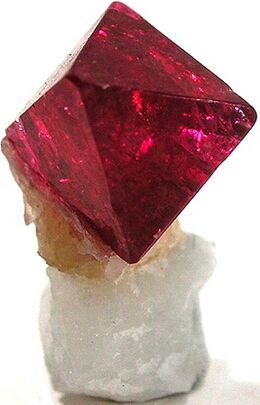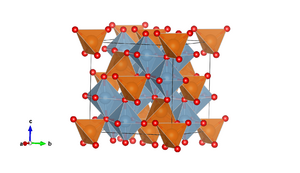Spinel facts for kids
Quick facts for kids Spinel |
|
|---|---|

A small spinel crystal on white calcite from Mogok, Myanmar.
|
|
| General | |
| Category |
|
| Formula (repeating unit) |
MgAl2O4 |
| Strunz classification | 4.BB.05 |
| Crystal symmetry | F 4 3 m (No. 216) |
| Unit cell | a = 8.0898(9) Å; Z = 8 |
| Identification | |
| Color | Many colors: red, pink, blue, violet, green, brown, black, or clear |
| Crystal habit | Octahedral (eight-sided) crystals, sometimes flat triangles |
| Crystal system | Cubic |
| Twinning | Common (crystals growing together) |
| Cleavage | None |
| Fracture | Conchoidal (shell-like breaks) |
| Mohs scale hardness | 7.5–8.0 |
| Luster | Vitreous (glassy) |
| Streak | White |
| Diaphaneity | Transparent to opaque |
| Specific gravity | 3.58 to 3.61 (can be higher for rare types) |
| Optical properties | Isotropic (light travels same speed in all directions) |
| Refractive index | 1.719 |
| Other characteristics | Can be weakly magnetic; some types glow under UV light (fluorescent) |
Spinel is a fascinating and colorful mineral that belongs to a larger family of minerals called the spinel group. It's made of magnesium and aluminium combined with oxygen, and its chemical formula is MgAl2O4. Spinel crystals usually form in a cubic crystal system, meaning they have a very organized, cube-like internal structure. The name "spinel" comes from the Latin word spinella, which means "little thorn," probably because of its sharp, pointed crystals.
Contents
How Hard is Spinel?
Spinel is a very durable mineral. On the Mohs scale of mineral hardness, which measures how scratch-resistant a mineral is, spinel ranks between 7.5 and 8. This means it's quite hard, similar to topaz (8) and harder than quartz (7). This hardness makes it a great choice for jewelry.
Spinel's Many Colors
Spinel can be found in a rainbow of colors! It can be clear, or various shades of red, pink, lavender (a purplish-pink), blue, green, brown, or black. The color often depends on tiny amounts of other elements mixed in. For example, a small amount of chromium can make spinel appear red, while cobalt can give it a vibrant blue color.
Famous Spinel Gems
Some spinels are so large and beautiful that they were once mistaken for rubies and became part of royal Crown Jewels.
- The Black Prince's Ruby and the Timur Ruby are two famous red gemstones in the British Crown Jewels. For centuries, people thought they were rubies, but modern science showed they are actually spinels!
- The Samarian Spinel is the largest known spinel in the world, weighing an incredible 500 carats (about 100 grams).
Spinel vs. Ruby: A Historical Mix-Up
For a long time, people didn't have the scientific tools to tell the difference between red spinel and red ruby. Both were simply called "rubies." It wasn't until the 18th century that scientists realized they were two different minerals. The word "ruby" then became specifically for the red variety of the mineral corundum, and "spinel" was used for this distinct gem.
The term "Balas ruby" was often used for red spinels. "Balas" comes from Balascia, an old name for a region in central Asia (modern-day Badakhshan) that was a major source of these red gems.
How Spinel Forms in Nature
Spinel is usually found in rocks that have been changed by heat and pressure, called metamorphic rocks. You can often find it in changed limestones or certain types of mudstones. It can also form in some rare igneous rocks (rocks formed from cooled magma). This is why spinel and ruby are often found together, as they can form under similar conditions.
Spinel is also an important mineral deep inside the Earth's mantle, the layer beneath the crust. It's found at depths between about 20 kilometers and 120 kilometers.
Interestingly, spinel is also found in some meteorites! It's a common mineral in special parts of these space rocks called Ca-Al-rich inclusions (CAIs).
Major Spinel Locations Around the World
Spinel has been mined for centuries in various parts of the world.
- Sri Lanka has long been a source of gemstones, including spinel.
- The Badakhshan Province (in modern-day Afghanistan and Tajikistan) was historically a very important source of red and pink spinels.
- Mogok in Myanmar is famous for its beautiful spinel crystals.
- More recently, high-quality spinels have been discovered in places like Lục Yên District (Vietnam), Mahenge and Matombo (Tanzania), Tsavo (Kenya), and in the gravels of Tunduru (Tanzania) and Ilakaka (Madagascar).
- Since the year 2000, some locations have even found spinels with incredibly vivid pink or blue colors, sometimes called "glowing" spinels. These have been found in Mogok (Myanmar), Mahenge (Tanzania), and Lục Yên (Vietnam). In 2018, bright blue spinels were also reported in southern Baffin Island (Canada).
Man-Made Spinel
Synthetic spinel is spinel created in a laboratory by people. It's made using methods similar to those used for making synthetic corundum (like synthetic rubies or sapphires). One common method is the Verneuil method, which involves melting powdered ingredients and letting them crystallize.
Synthetic spinel is often used as a less expensive alternative to natural gemstones. For example, light blue synthetic spinel can look like aquamarine, and green synthetic spinel can imitate emerald or tourmaline. It's also a popular choice for birthstone jewelry, especially for the month of August.
Beyond jewelry, synthetic spinel has practical uses too. It can be made into strong, transparent sheets and other shapes through a process called sintering. This man-made spinel looks like glass but is much stronger, making it useful for military and commercial purposes where tough, clear materials are needed.
See also
- Aluminium oxynitride - Another strong, transparent material.
- Ceylonite - A dark variety of spinel.
- The Three Brothers - A lost 14th-century crown jewel featuring three red spinels.



